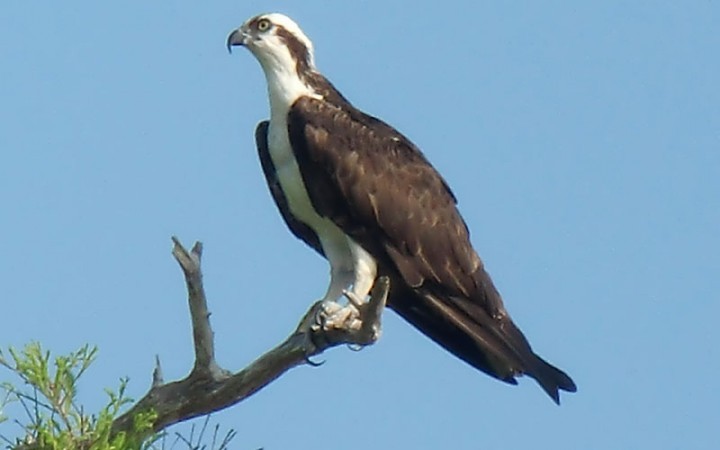
INDIAN RIVER COUNTY — Nature lovers have a rare opportunity this week to go on a naturalist-guided tour of Blue Cypress Lake, one of the most mysterious and pristine bodies of water in Florida. The Pelican Island Audubon Society is offering three-hour boat excursions twice-daily through Sunday, April 29.
Mystery surrounds the million-year-old lake 30 miles west of the Barber Bridge because of the remains of Native American civilizations that lie beneath its waves and because it somehow evaded detection by European and American settlers and adventurers for more than 380 years after the arrival of Ponce de Leon.
Even though American troops marched on a road just three miles from the western shore during and after the Seminole Wars, settlers, loggers and the military remained ignorant of the lake where it lay, wide and blue, hidden within a vast wetland which then rivaled the Everglades for size and wildness.
The10-square-mile lake didn’t show up on a map until 1895, 50 years after Florida became a state, and remains largely untouched to this day.
“It has never been spoiled,” says Audubon Chapter Vice President Bob Bruce. “It is probably the only lake in the state that has had so little development.”
Blue Cypress Lake – named for the centuries-old trees that surround it and the color of its water at certain times of day – narrowly escaped land developers and agricultural interests intent on building houses on the eastern shore and growing sugar cane on the swampy land that stretches toward the coast.
Much of the land around the lake was platted and canals were dug for drainage, but floods and other difficulties caused a series of grand plans to collapse. Much of the platted area is now permanently preserved wetland that acts as an ecological moat, protecting the lake from the type of nutrient overload that is poisoning the lagoon.
“There is only one road that leads to the lake,” says Richard Baker, professor emeritus at the University of Florida and president of the Pelican Island Audubon Society. “The only development is at Middleton’s Fish Camp, where there is a boat ramp and small park, and Blue Cypress Village right next to it.”
Blue Cypress Village is a cottagey cluster of 60-some trailers and houses on finger canals that was built up over a period of decades beginning in the 1950s.
Besides the small human colony perched on the western shore, the lake is home to more than 75 species of birds along with hundreds of other animals and plants ranging from plankton to alligators.
The most prominent residents this time of year are hundreds of osprey that return from their South American wintering grounds to mate each spring. Baker, who has written a book about the lake with his wife, Juanita, says he has counted 150 of the large, ragged-looking branch-and-twig nests osprey build as lofty nurseries for their young.
With a mated-for-life pair in each nest and two or three chicks maturing into fledglings that fly and fish alongside their parent trainers, there will be approximately 600 of the impressive birds of prey soaring and diving along the shores of the lake this spring.
Sometimes called fish hawks, the powerful raptors stand two feet tall, have six-foot wingspans and dive at speeds up to 50 miles an hour to pluck unwary fish from the lake’s pure water.
Carrying the fish head-forward for better aerodynamics, the male birds, which do most of the hunting this time of year, return to the treetops to feed their mates and growing offspring.
The abundance of osprey activity at the lake is the reason the Audubon Society decided to offer its April tours.
“Blue Cypress Lake is the second or third most active nesting site for osprey,” says Baker, who will guide the excursions.
Bruce will provide and pilot the tour boat, a 21-foot Hurricane with a cathedral hull manufactured by Godfrey Marine with room for 10 passengers.
The boat’s model name is somewhat ironic for Bruce.
“I got it after the hurricanes in 2004,” he says. “The storms destroyed my previous boat.”
Powered by a 115-hoursepower Yamaha four-cycle engine, the shallow-draft craft can scoot across the water at exhilarating speed or quietly cruise in among the cypress trees near the shore where osprey nest.
“Charlotte Terry is letting us keep the boat at her dock in Blue Cypress Village while we do the tours,” Bruce says.
Baker and Bruce took about 120 people out on the lake in a first round of tours in early April, many of them amateur photographers eager to capture the majestic birds in digital form.
“I don’t think anybody came away from the experience not totally awed,” says Bruce.
The tours, which are offered each morning and afternoon this week through Sunday, include refreshments and cost $75 per person. Money raised will be used to help fund the Pelican Island Audubon Society’s long-planned office and nature education center adjacent to the Oslo Riverfront Conservation Area.
Call (772) 567-3520 for more information or to make reservations or visit http://www.pelicanislandaudubon.org.



